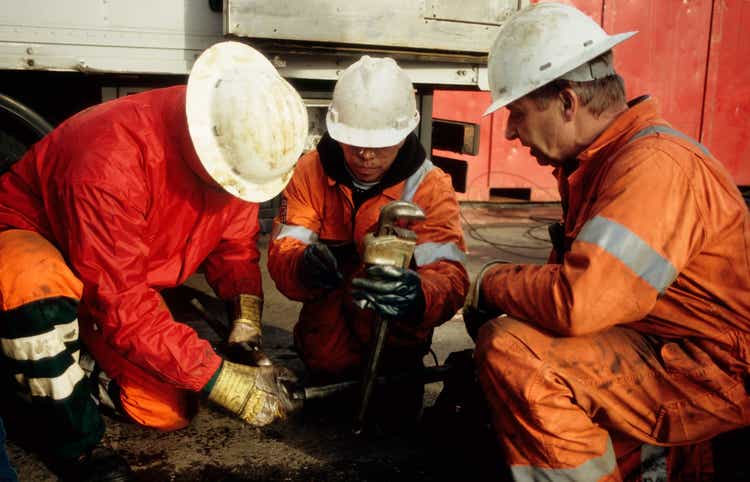claffra
My last take on Schlumberger (NYSE:SLB) dates back to April 2020, when the outbreak of the pandemic was taking the world by surprise, sending many shares into turmoil.
I observed that shares were seeing continued woes as management moved to cut the dividend after relative solid first quarter results, with investors fearing a slowdown in the operations, as the company torched along quite some debt at the time. In fact, I called management too aggressive with capital allocation in the past having resulted in a debt load as the company entered a period of great turmoil.
Where Do We Come From?
Schlumberger was once regarded a top notch player in the oil and gas service sector, with shares peaking comfortably above the $100 mark when US shale production, at least the enthusiasm in that sector, peaked. What followed was steep stagnation as shares fell to the $40 mark ahead of the pandemic already on the back of headwinds in the business, poor acquisitions, and too aggressive capital allocation strategies (read too high dividends, and too many buybacks).
With oil prices plunging following the outbreak of the pandemic, it was this uncertainty and debt which caused me to believe that shares of Schlumberger effectively represented a call option at the time. This came as a $33 billion business in 2019 reported earnings of just around $1.50 per share on the back of a $3 billion operating profit number. Net debt stood at $13 billion which was substantial in relation to the (adjusted) operating profits, as dividend commitments ran at nearly $3 billion a year as well.
Even as first quarter sales for 2020 were down just 5% to $7.5 billion, I believed that full year sales might plunge by $10 billion as a result of the poor conditions out there, although that capital spending might lag depreciation charges by a great amount, providing some near term cash flow stabilization. The company furthermore announced a 75% cut in the dividend to an annual payment of $0.50 per share, while capital spending of $1.2 billion seen in 2020 would lag depreciation expenses by about $1.8 billion.
With shares trading at $1 at the time, I found myself puzzling what to do with a position which I had initiated late in 2019, yet not willing to bail out given the measures taken and the observation that Schlumberger was key in the vital operations of the economy and sector. This made me believe that some kind of assistance would likely be seen if the company would not make it on its own.
Slowly Coming To Life
After a tough 2020, in which shares continued to trade near their lows, shares have gradually moved higher as economies and oil prices rebounded in 2021. Shares rallied in 2022 amidst geopolitical tension, now trading at $50 per share again, marking really solid gains even as economies and oil prices are not out of the woods yet.
As it turned out, 2020 sales did eventually fall to $23.6 billion, in line with my expectations. After posting multi-billion losses in 2020, the company reported a profit of $1.9 billion again in 2021, even as sales fell another 3% to $22.9 billion. Net debt has steadily fallen to $11 billion, with no dilution incurred along the way.
After posting a 14% increase in first quarter sales, the company hiked the dividend by 40% to a run rate of $0.70 per share, still a long way short of the $2 per share dividend ahead of the pandemic. After revenues rose 20% in the second quarter, the company guided for revenues to come in at least $27 billion in 2022, accompanied by some margin expansion.
With energy prices spiking and inflation boosting sales growth, the company posted a 28% increase in third quarter sales which makes a $27 billion sales guidance conservative, with earnings likely coming in around $2.25 per share, or more. This all happened as net debt fell further to $10 billion, rapidly getting more manageable as improved earnings power results in EBITDA trending around $7 billion a year here.
Outside benefiting from a recovery in energy markets and Schlumberger’s customers, the company is in transition as well. Besides changing its name to SLB, the company focuses more on climate change, positioning towards carbon offset, climate technologies and decarbonization of oil & gas production.
What Now?
Reality is that shares of Schlumberger have rallied to the $50 mark, being just a $40 stock late in 2019. In the meantime, sales are now trending around $28-$30 billion, below the 2019 numbers, which accounted for inflation suggests still substantial volume declines amidst elevated oil and gas prices, as investments into the sector are much more restrained now. This is due to ESG practices and more conservative capital spending plans by major players in the field.
With earnings power around $2.25 per share largely in line with the pre-pandemic performance, the company has been able to cut net debt by around $3 billion, but that adds up to just $2 per share, as earnings multiples come in around 20 times based on current earnings multiples. Of course, this remains a huge hedge on the political unrest as SLB is positioning to move away from just oil & gas, focusing especially on climate as well, although there is a very long road to go.
Still holding a tiny position from 2019, shares have moved more or less in line despite a tough pandemic, as shares have definitely lagged producers in 2022. This creates for a difficult set-up, and while I am happy to hold onto my position here, I see no reason for actively adding to this position, but no huge reason to cut my stake here as well..


Be the first to comment